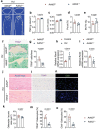Unloading-Induced Skeletal Interoception Alters Hypothalamic Signaling to Promote Bone Loss and Fat Metabolism
- PMID: 37880864
- PMCID: PMC10724445
- DOI: 10.1002/advs.202305042
Unloading-Induced Skeletal Interoception Alters Hypothalamic Signaling to Promote Bone Loss and Fat Metabolism
Abstract
Microgravity is the primary factor that affects human physiology in spaceflight, particularly bone loss and disturbances of the central nervous system. However, little is known about the cellular and molecular mechanisms of these effects. Here, it is reported that in mice hindlimb unloading stimulates expression of neuropeptide Y (NPY) and tyrosine hydroxylase (TH) in the hypothalamus, resulting in bone loss and altered fat metabolism. Enhanced expression of TH and NPY in the hypothalamus occurs downstream of a reduced prostaglandin E2 (PGE2)-mediated ascending interoceptive signaling of the skeletal interoception. Sympathetic antagonist propranolol or deletion of Adrb2 in osteocytes rescue bone loss in the unloading model. Moreover, depletion of TH+ sympathetic nerves or inhibition of norepinephrine release ameliorated bone resorption. Stereotactic inhibition of NPY expression in the hypothalamic neurons reduces the food intake with altered energy expenditure with a limited effect on bone, indicating hypothalamic neuroendocrine factor NPY in the facilitation of bone formation by sympathetic TH activity. These findings suggest that reduced PGE2-mediated interoceptive signaling in response to microgravity or unloading has impacts on the skeletal and central nervous systems that are reciprocally regulated.
Keywords: bone metabolism; microgravity; neuropeptide Y (NPY); skeletal interoception; tyrosine hydroxylase (TH).
© 2023 The Authors. Advanced Science published by Wiley-VCH GmbH.
Conflict of interest statement
The authors declare no conflict of interest.
Figures







References
-
- Garrett‐Bakelman F. E., Darshi M., Green S. J., Gur R. C., Lin L., Macias B. R., Mckenna M. J., Meydan C., Mishra T., Nasrini J., Piening B. D., Rizzardi L. F., Sharma K., Siamwala J. H., Taylor L., Vitaterna M. H., Afkarian M., Afshinnekoo E., Ahadi S., Ambati A., Arya M., Bezdan D., Callahan C. M., Chen S., Choi A. M. K., Chlipala G. E., Contrepois K., Covington M., Crucian B. E., De Vivo I., et al., Science 2019, 364, eaau8650. - PMC - PubMed
-
- Vico L., Collet P., Guignandon A., Lafage‐Proust M.‐H., Thomas T., Rehailia M., Alexandre C., Lancet 2000, 355, 1607. - PubMed
-
- Fitts R. H., Riley D. R., Widrick J. J., J. Appl. Physiol. 2000, 89, 823. - PubMed
-
- Aubert A. E., Beckers F., Verheyden B., Acta Cardiologica 2005, 60, 129. - PubMed
Publication types
MeSH terms
Substances
Grants and funding
LinkOut - more resources
Full Text Sources
Miscellaneous
